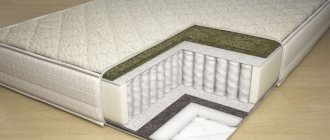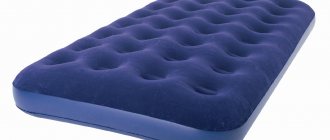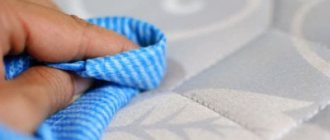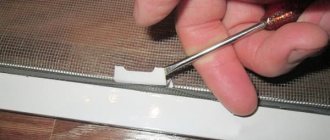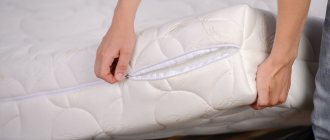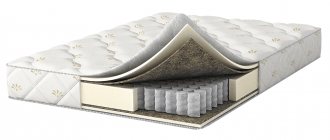A mattress is a soft bed base that can be with or without a frame. It comes in several types, but in everyday life, only two are most often used - spring and stuffed. In our article we will talk specifically about spring types, which, in turn, are divided into two types.
- With a continuous weave of springs called Bonnell
- With independent blocks of springs, which are considered orthopedic
The first type is more common. It is inexpensive, so it is very popular. The second type has greater capabilities, but is also more expensive. In any case, the subject of discussion consists of a spring block or shock-absorbing parts, a hard layer, a cover and a filler. The latter can be both soft and hard. As for the covering, it is better that it be made of natural fabric.
Mattresses with continuous weave springs
Products of this design can be found in any house or apartment. Many consider them outdated, but this in no way diminishes their popularity. And all because of the low cost. Mattress cushioning parts are made from a material such as hardened high-carbon steel. They are connected to each other using wire. The main disadvantage of bed elements of this type lies in the fact that they have extremely low orthopedic properties. This is because when you lie down on the bed, not just one spring responds, but all at once.
Do-it-yourself foam mattress - an interesting and exciting process
Do-it-yourself foam mattress - who might be interested in this topic? First of all, for those who plan to become a professional furniture maker in the future and are already trying themselves in this business. Also for those who want to save on buying a new orthopedic mattress. Making a sleeping item with your own hands eliminates the need to pay for the work - you only have to spend money on materials. And, finally, for those who simply love to tinker, create, are not afraid to take on the unknown and want to understand “how the world works and everything in it”!
When does a mattress need repair?
The outer covering of spring mattresses deteriorates most quickly. But the fillers for them are made from high-quality materials that have a long service life. The average service life of a spring product is fifteen years. When it loses its functional parameters, you should not throw it away immediately. Bringing the product into proper shape is not so difficult. There are several reasons why a mattress begins to require urgent restoration methods.
- Damage to the casing
- Deformation of flexible elements
- Filler wear
- Violation of the structure
But this list can be expanded with a more thorough examination of this item. To repair a spring mattress with your own hands, there is no need to have special knowledge and skills. You just need to carefully follow the advice of more experienced specialists.
Preparation for repair
The desire to repair a mattress arises against the background of the appearance of external defects or damage. The most common breakdowns include:
- Formation of holes and abrasions on the outer upholstery.
- Wear of the soft surfaces that separate the springs from the casing.
- Deformation of the base or frame.
- Damage to springs.
Stages of the recovery process
The work of bringing an old mattress back to life can be divided into several main stages.
4) Bringing damaged parts into the correct position
5) Reliable strapping of shock-absorbing parts
6) Checking the parts that have been repaired
7) Sheathing of the product
Materials and tools
To restore a worn product to its proper form, you must use the following materials and tools.
1) New decorative trim
2) Lining fabric
3) Padding material
6) Furniture stapler
7) Wooden slats
 Durable yet flexible cord
Durable yet flexible cord
Stage 1. Clean and inspect the repair item
During active use of the product, quite a lot of small debris, that is, dust, accumulates inside it. That is why experts recommend doing disassembly on the street. If this option is not considered, then you will need a vacuum cleaner. With its help, all surfaces of the spring product must be thoroughly cleaned. It is advisable to remove all furniture and carpets from the room in which the renovation process will take place. As a last resort, cover all objects in the room with oilcloth or similar material. Place the product on four stable benches so that the decorative trim is on the bottom. This will allow you to approach the repair item from all sides. Very carefully pull out all fastening parts from the mattress. After this, you need to remove the upholstery material and seal. The fabric that covers the springs also needs to be removed. Clean all elements with utmost care.
Stage 2. Inspect the parts
You must release the springs from the bindings. After this, you can begin to remove the nails from the base. These are what manufacturers use to secure the harnesses. Now you need to bring all the spring elements into a vertical position. Be careful! All springs must be the same height. All parts that are not held firmly or have come off completely must be securely attached to the slats with nails. Please note that if the mattress springs are attached using straps, then these straps must be removed. And the spring parts are secured using nails.
In general, all straps in our facility must be eliminated. It will be better if you use regular slats instead. The latter should have a length equal to the width of the mattress. To secure them, you need to make preliminary markings on the body.
Stage 3. Attach the slats
Before getting rid of the frame's fastening tape, mark on its surface the places where the tape was placed. After this, you need to carefully remove the nails and remove the old straps. Now you need to prepare the slats of the required size. Then, according to the markings made, you must carefully cut out the grooves for them. After this, the slats are very carefully nailed on both sides to the base. Next, you can install the spring elements in their previous position. If necessary, straighten them and secure them with nails. The latter are bent on both sides to ensure high reliability of fastening.
Installation of plasterboard ceiling
1. At what pitch are the suspensions attached to the ceiling - on the Knauf website I read that the pitch of the main profiles is 1200 mm, the pitch of the suspension is 650 mm. That sheet hangs on two main profiles and supporting bearings adjacent to them (if according to technology, the sheet is along the main ones) and on 6 hangers... Seems to be quite rare - won't it all fall?2. How is the direct suspension attached - with two dowels or one? Again on the Knauf website in the forum info. The department answers that there is one, but in the middle of the suspension there is not a hole, but a slot along which the dowel-nail can slide, and the suspension can warp.3. How to attach an isover to the ceiling?
- 550 replies
How to extend the life of a mattress
It is clear that one mattress is unlikely to last you a lifetime. Over time, it will still need repairs. But we note that the moment when there is nowhere to go can be delayed for a very decent period. To do this, you need to use this piece of furniture with the utmost care. Try to avoid situations that could damage it.
- You need to buy a mattress according to your weight
- Don't let children jump on the bed
- Never eat or drink while lying on the bed
- Be sure to let the item dry and ventilate in the fresh air at least once a year.
- The mattress should only be placed in the places intended for it
- To prevent the decorative covering of the mattress from getting dirty, use additional removable covers
If you carefully follow all these simple rules of operation, then your mattress will serve you for many years, and its repair will not be needed very soon. This is a guarantee that your sleep will be healthy and sound.
The article was prepared with the help of specialists from the Sleep Laboratory. Website: https://sleep-lab.ru/ - Online mattress store.
Video. Spring mattress repair
Video. Do-it-yourself mattress repair and reupholstery
All spring mattresses that are on the market can be divided into two large categories - with dependent springs and with independent spring blocks. The fundamental difference is how they work under load. In a dependent block, the load is distributed among all springs simultaneously, creating a hammock effect. In an independent one, each spring works separately, which creates increased comfort.
Mattresses with dependent and independent spring block
Mattress cover
When all the springs and fillers are in order, it is time to create a new cover. This is not required, but recommended. After all, the fabric in the bed is a breeding ground for mites and harmful microorganisms. And since you can’t boil the cover, you need to replace it with a new one! It can be bright and optimistic, but psychologists and sewing technologists recommend light-colored upholstery, since it does not strain the eyes and does not show through white sheets.
Meaningful choice
When searching for “spring mattress repair in Moscow,” a lot of advice appears on how to do it yourself. But it's better not to do this. Because any furniture must be disassembled by someone who knows how to assemble it. Experienced craftsmen always have special tools and technologies at hand that the average person does not have. Therefore, it is better not to create unnecessary problems for the craftsmen, but immediately, without independent intervention, take the repair object to the studio.
For those who cannot transport bulk cargo, special conditions apply for delivery by the studio. And this is an important plus when choosing a restorer. Well, the main thing is that the price is very reasonable even for a family with a modest income.
Want to make sure? Get ready to name the dimensions of the bed and call the studio right now!
How the mattress works
A mattress with dependent springs consists of a metal frame on which springs are installed, rigidly fastened together and forming a single block.
The structure of a mattress with dependent springs
The most common is the Bonnell spring unit, invented more than 150 years ago, which contains from 120 to 160 springs per square meter. The spring consists of coils of different diameters - maximum at the edges and tapering towards the center. Thanks to this, they do not rub against each other and do not make increased noise.
Mattress based on Bonnell dependent spring block
The most common are five-turn steel springs made of hardened wire; four-turn springs are less commonly used. Dependent spring blocks are used in the production of upholstered furniture - sofas, ottomans, and are also produced for the production of mattresses for beds.
This block system consists of spring elements of a special cone shape, which are fastened together with a spiral wire made of hard carbon steel
This type of mattress is still in great demand among buyers due to its practicality and durability. The cost of this product is 30–40 percent lower than independent spring mattresses.
In a mattress with independent springs, which are called orthopedic, the springs are in covers made of non-woven material, which are glued together into a single block.
Bed mattress based on an independent spring block
With this scheme, the load is distributed more evenly, which allows the body to take a natural position when sleeping.
In this system, each spring element in the shape of a cylinder or “barrel” is located in its own special case made of thick fabric or elastic materials
An orthopedic mattress prevents the occurrence of back diseases, the sleeper’s blood circulation is not impaired, and a person wakes up in the morning rested, without pain.
Independent spring block for orthopedic mattresses
The greater the number of springs used per square meter, the more pronounced the orthopedic effect.
There are 3 types of hardness:
- high, recommended for weights over 95 kg;
- average, weight from 60 to 95 kg;
- soft, weight up to 60 kg.
According to the number of springs, mattresses are divided into:
- multipack TFK, with 250 springs. per square meter;
- multipack S 1000–500 pcs.;
- multipack S 2000– 1000 pcs.
Repairing mattresses at home as a business
To start a mattress repair business at home, you don’t need to have a lot of start-up capital. But before you start working in this service sector, you need to analyze the demand market in your region and determine the percentage of competitive entrepreneurs.
The main costs will be associated with registering an individual entrepreneur, purchasing consumables and tools necessary for work. It is better to buy upholstery fabrics, fillers, substrates and shock-absorbing elements at wholesale stores or from manufacturing plants.
What is a spring mattress made of?
Composition of a mattress with a Bonnell spring block
The mattress consists of the following elements:
- spring block;
- an underlying layer of non-woven material or burlap;
- sealing layer, materials used – heat-pressed felt, coconut coir, polyurethane foam (foam rubber), struttofiber, latex, highly elastic foam;
- The top layer is a cover, made of natural fabrics - linen, cotton.
Composition of a spring mattress with an independent block
How to sew a mattress cover?
Mattress cover. The principle of sewing a mattress cover is similar to the algorithm for sewing a mattress cover. The difference is that a mattress pad does not have to fit as tightly around the mattress as a cover does.
With corner elastic bands. You can limit yourself to sewing a simplified thick mattress cover-dust cover with corner elastic bands.
With elastic around the perimeter. Another simple model: a mattress cover with sides, held in place by an elastic band pulled into the drawstring (along the perimeter).
Repair of mattresses with spring blocks
The service life of spring mattresses is 8–15 years. But sooner or later the question of replacing or repairing it arises. In some cases, it is preferable to repair the mattress and save 30–40 percent of its cost. What is mattress repair?
Over time, the highest quality mattress loses its properties - dips appear, springs burst, shape changes, the covering fabric becomes frayed and dirty.
In this case, there are two ways - buying a new mattress or repairing the old one.
The easiest way is to contact a mattress reupholstery workshop, where specialists will carry out a comprehensive repair of your product, replace the entire spring block, or, if there are only a few damaged springs, replace individual elements. A mattress that has undergone high-quality repairs in a workshop is not inferior in its properties to a newly purchased one.
How to shrink a mattress at home
In some cases, the mattress may need to be altered; for example, its size may not fit the bed, or it may be too high.
When an old foam mattress is not the right size for a new bed, the easiest way to cut it is to cut it
If the product does not have springs, the task is extremely simple - cut the seams and remove unnecessary filler material. Carry out the work as carefully as possible. After removing the excess, sew the seams.
You can easily reduce the size of the mattress yourself. The main thing is to carefully sew up the product.
If springs are present, then to reduce the height you will have to remove the excess spring block.
DIY spring mattress repair
If a spring mattress has become partially unusable, do not rush to throw it away - try to repair it
Having skills in household repairs and a minimal set of tools, you can perform such repairs yourself.
For this job you will need tools.
- Pliers
- Side cutters
- Flat screwdriver
- Hammer
- Furniture stapler with staples
Materials and consumables needed for repairs:
- springs (can be used from an old block of a similar shape and height);
- fabric for lining;
- padding material;
- nails;
- durable cord with a cross section of 4–6 mm;
- new case.
First you need to disassemble the mattress
After this, you need to inspect the springs and set them all in the correct position.
After all the springs are evenly and firmly fixed to the frame, we carry out the strapping
You will need a strong rope for tying
We check that all the springs are the same length and cover the mattress with lining fabric, securing it around the perimeter
Covering the mattress with a new cover
Repairing a spring mattress begins with removing the old upholstery. It is better to carry out this work outside the house, since during operation, a large amount of debris, dust, and decomposed foam crumbs have formed in it. When disassembling at home, you need to prepare a vacuum cleaner and cover the floor with plastic film.
Once the upholstery is removed, the filler is carefully rolled up. It can be foam rubber, coconut fiber, batting. The lining fabric is removed. After cleaning the frame from old staples, nails, foam rubber residues and other non-woven materials, proceed to inspect the spring block. The steel frame surrounding the perimeter of the mattress is checked.
The metal frame encircling the spring block can be either one-sided, in less expensive models, or used in furniture production, or on both sides. A block with a double-sided frame is close in performance to orthopedic mattresses.
Tools needed for repairs
The choice of tool depends on the damage to the mattress. If you need to replace the upholstery, you will need glue and a fabric of suitable size and structure that will not tear after several months of use. If the problem is in the metal structure, you will have to buy new springs to repair the mattress.
p, blockquote 13,0,0,0,0 —>
p, blockquote 14,0,0,0,0 —>
Materials and tools that may be needed for repairs:
- Metal wire or elastic cord.
- A backing that can be used with any durable and breathable fabric.
- Wooden slats 70×20 mm.
- Decorative cladding.
- Nails, hammer.
- Furniture stapler.
- Decorative cladding.
- Thread, needle or sewing machine.
- Glue gun.
- Scissors.
- Pliers.
p, blockquote 15,0,0,0,0 —>
Repairing or restoring a spring mattress for a bed with your own hands involves: removing the upholstery material, replacing the necessary elements, tying the springs and final covering.
Spring block repair
If out of the entire array of springs there is not a single broken one, and the central or side part has only sagged a little, then only the sagging elements are replaced
Damage to the frame is repaired, broken springs are removed, and new ones are installed in their place. The springs are fastened together using wire. The block is attached to a base of wooden slats using fabric straps, staples or nails. We remove all the old fasteners, align the springs on the slatted frame and re-secure them with nails or furniture staples. Nails 40-50 mm long should be used. To fasten the springs, the nails are driven in half their length and bent across the coil on both sides. To give additional rigidity, it is better to strengthen the spring block with a strong nylon cord. Along the perimeter of the wooden base, opposite each spring, nails are hammered into which the cord is attached. The rows of springs are alternately secured with a cord using a strapping. First, transverse rows are tied, then longitudinal and diagonally at 45 degrees. At the end of tying, the nails with the attached cord are bent.
If the location of the breakdown is a break in the steel frame, then the joint can be repaired by welding or, most simply, stuffing a copper tube
Repair of a mattress with independent blocks
Independent springs can also become deformed if used incorrectly
After disassembling and removing the sealing layer, the spring block should be inspected.
The most common damage is rupture of the fabric of the spring bags and disruption of the adhesive connection of the covers to each other, tearing of the springs from the frame, bending of the frame.
When the spring block is damaged, you need to cut out the damaged part, usually the middle part of the mattress
After inspection and identification of damage, they begin to eliminate them. The frame is checked and, if necessary, leveled. If broken springs are found, they should be replaced with new ones of the same shape. Bags that have become unusable are replaced.
We cut to size a spring block of the same height and density with the same number of springs per square meter and insert it in place of the old springs
To glue spring bags, it is recommended to use a glue gun with fabric glue sticks. The covers are glued in the center for one third of their length to maintain the orthopedic effect. After gluing the springs together, the attachment of the bags to the frame is checked. In places where they are absent, springs are attached to the frame using plastic ties or wire. Finally, a sealing layer is placed on the block and a cover is put on.
Place a coconut leaf on the spring block
You can lay foam rubber or natural latex on a coconut sheet to give it softness, or felt or padding polyester to make it stiffer.
A self-repaired mattress can last more than 5 years. Repairs take little time and can be completed within one working day. And work done with your own hands will bring satisfaction. Another undoubted advantage is a decent saving of money, which can always be used in any family.
Repair features
According to the place of use, mattresses are:
- for bed;
- for the sofa.
These types of soft products are almost the same, only the sofa ones have a more rounded surface and will require more lining material.
- disassembly,
- trouble-shooting,
- assembly.
The most unpleasant stage is disassembly, because over the years of operation a lot of dust and dirt has accumulated inside the spring frame. Therefore, it is better to carry out all disassembly work on the street or in a non-residential premises, for example, in a barn or garage, and when working in residential premises it is recommended to have a vacuum cleaner on hand.
- The outer skin is removed. This is done by using pliers to pull out the nails or clips that secure the outer cladding to the wood frame.
- After the lining is removed, a fabric flooring made of burlap (other similar materials are possible) and a soft base will become visible. The upper part of the flooring cannot be restored and is completely thrown away. The soft base can be either completely replaced or partially restored if desired, but it is advisable to remove it during repair work, this will help to carry out a more complete diagnosis of all spring connections.
After removing all the upholstery materials, you can start looking for faulty springs. It should be taken into account that on orthopedic models each spring is secured in a separate bag, and on regular models it has the following mounting options:
- Nailed to wooden slats using nails. Sometimes it happens that there is no need to replace the springs; it is enough to fix the loose ones with a hammer and nails.
- The springs are secured to wooden slats using fabric straps. It is better to replace the straps with new ones during repairs.
- On fabric belts that replace the slats at the bottom of the sofa frame. This is the most modern option, partially providing the mattress with orthopedic properties. It is advisable to change not only failed springs, but also fabric straps. Sometimes during restoration operations the straps are replaced with strong slats, but this increases the rigidity of the product.
When restoring mattress structures with your own hands, you must:
- Check the entire spring base; perhaps some of its elements will need to be additionally secured or corrected.
- Replace it, securing it with nails and wire to adjacent springs using a standard structure. On orthopedic devices, a spring bag is sewn in place to replace the damaged one using a regular needle and strong thread.
After checking and troubleshooting, you need to reassemble the mattress. To do this, the following operations are carried out:
- A new or partially restored soft base is distributed evenly over the springs.
- Burlap or similar fabric is stretched over the base for fixation, its ends are attached to the mattress frame.
- The old upholstery is ripped out and a new one is made using its pattern. If there is no desire to completely change the covering, then it must be washed and repaired, eliminating minor damage (you can sew on decorative appliqués or simply install a patch from the repair kit that was included at the time of purchase).
- The decorative base is secured to the frame using a stapler or nails. To make caring for the product easier, especially if the upholstery has not been replaced, but only restored, it is advisable to sew an additional cover with a zipper on the bed mattresses, which will make caring for the product much easier.
That's all, you can again fully relax on a soft product repaired with your own hands.
Despite the apparent complexity, it is possible to repair spring mattresses yourself by purchasing some materials and using tools that are found in any home. The advantage of such a restoration is that your favorite item can still serve for a long time, giving a positive emotional mood and saving money.
A high-quality mattress can please you for more than 10 years, but one day you may realize that it needs repairs and reupholstery. The most vulnerable part of the product is the casing; the internal filling suffers less, although the springs also periodically need repair.
If you notice that your mattress no longer meets the requirements, the springs have become deformed, creaking has appeared, or the design as a whole has become different, do not rush to get rid of it. You can restore the product yourself, using a number of proven actions.
Types of faults
There are two types of spring mattresses: with an independent spring block and with a continuous weave of springs. Modern orthopedic mattresses in most cases are equipped with separate blocks of springs; continuous weaving is found in old-style mattresses.
During repairs, the user may encounter various breakdowns:
- the need to replace external upholstery or sealing material;
- disconnecting the spring from the base;
- deformation of the spring block;
- cracks in the mattress frame.
A number of tools are required to carry out the work:
- hammer and pliers;
- nails (regular 50-60 mm and furniture);
- clamps;
- stationery knife or scissors;
- needle and strong thread (preferably regular thick or silk);
- sealing material – synthetic winterizer or foam rubber;
- durable cord (recommended thickness 5 mm);
- manual or electric stapler, staples;
- spare springs.
What will you have to face?
Of course, there are quite a lot of options for mattress breakdowns and their combinations. But, as a rule, people who start repairs have to face one of the following problems:
- the need to replace upholstery materials;
- damage to the sealing material;
- springs disconnected from the base;
- deformation of spring blocks;
- cracks in the mattress arm.
Usually, the problem is rarely the only one; as a rule, a combination of them is observed. This is especially true for old things that have been repaired many times.
Stage 1: Removing the upholstery and cleaning
Experts recommend repairing a mattress outside or in a garage, but if this is not possible, it is permissible to do it at home. The entire structure should be placed on a flat horizontal surface or several stools so that the structure can be approached from any side.
In most cases, the top decorative cover is closed with a zipper along the entire perimeter; it is easy to remove and remove the structure itself. If the outer material is stitched, it should be ripped apart; it is not necessary to cut all the seams; it is enough to separate the parts of the cover on one side. Then carefully remove the sealing and cushioning fabric that covers the springs.
In modern mattresses, the lining fabric is glued with strong glue. To remove it, carefully cut the glued seams with a sharp knife.
If the mattress has been in use for a long time, a large accumulation of dust may form in it, which should be removed with a household or car vacuum cleaner. At this stage, you should thoroughly clean all parts of the mattress. If the sealing and lining material has become unusable, it is recommended to replace it with a new one or wash it.
Necessary materials
The choice of tools depends on the cause of the damage. To replace the upholstery by hand, all you need is glue and a matching fabric. If the integrity of the springs is damaged, you will have to stock up on new parts. The main things you will need during a major overhaul are new upholstery, a hammer, and nails.
You'll need:
- furniture stapler;
- elastic cord;
- filler (foam rollers);
- decorative cladding;
- lining (any breathable and durable fabric);
- slats (7 x 2).
When troubleshooting, it is important to also have pliers and wire on hand. All work is divided into several stages
First, the mattress is disassembled, then new springs are installed, the binding is made, and finally the product is sheathed (assembly).
Disassembling the mattress
The best place for repairs is a barn or other non-residential premises. During the period of operation, dust and particles of debris accumulate inside the product. Therefore, a good option is to use a vacuum cleaner when working.
First, the mattress is turned over with the outer surface down. Position it to ensure a flat surface. To make it easy to approach the mattress from each side, it is placed on four stools. Next, carefully free the product from its contents: remove old nails, remove paper clips with pliers, remove the decorative fabric of the upholstery and take out the soft rollers.
Stage 2. Inspection and repair of spring blocks
Springs are located under the lining fabric, sometimes they are wrapped in individual covers. The entire spring harness is secured to nails nailed to the frame - they should be bent or removed. At this stage, you need to inspect all the blocks; each spring must be securely attached to the base. If any elements move freely or the fastenings are worn out, they should be replaced and the parts should be secured with clamps or nailed with slats.
There are several methods for attaching spring blocks: on slats, on clamps, on straps. It is enough to examine how the others are recorded.
The most important thing is that the spring is securely attached to the base. If you don’t have the necessary materials at hand, you can make do with improvised means - thick nylon clamps, pieces of leather belt, metal staples for self-tapping screws.
In some mattresses, the springs are tied together with wire - there is no need to remove all of it, it is enough to bend it only in those places where the blocks have sagged. After replacing the springs, the wire is bent to its previous position.
If wooden slats have become unusable, you can also replace them yourself. Before removing the old ones, you should mark on the frame where the fixing straps are attached. After this, you can remove the nails and fastening tape. On new slats you need to cut out holes (grooves) and attach them to nails on both sides.
Products using springs
Spring models are easy to make. It is worth using purchased springs. It’s easy to choose them by asking the store for special materials for making furniture. If you do everything correctly, you will get an orthopedic mattress with your own hands. Sometimes it is enough to use springs from an old mattress or sofa and make new upholstery. It is recommended to use foam rubber. It’s easier to create an orthopedic mattress with your own hands if you have:
- Spring mechanisms;
- Dense material;
- Foam rubber.
To make your own mattress you will also need twine. They need to tie the springs tightly together. Afterwards, display your structure and place it under the bottom of the slats. Pin. Spring structures add density to the product. Afterwards you need to use filler. Pull the cover on top. Do-it-yourself orthopedic mattress is ready.
So, to make a mattress with your own hands, you don’t need to make a huge effort
But it is important to be able to cut the material by making the correct measurements. It is necessary that the density of the foam rubber be high
Spring designs are also popular, but their manufacture will require more time, skill and material. An orthopedic option that is suitable for any person will be more convenient.
Stage 3. Tying spring blocks
When all the springs are securely fixed to the frame, they need to be tied. It's very easy to do.
- You need to drive a nail opposite each row of springs at the level of the frame (you can see how the springs were initially fixed).
- All nails are bent with hooks.
- First of all, fix the two outer springs of the horizontal row.
- Next, fix the springs vertically.
- When all the longitudinal rows are tied, they finish tying the transverse ones, and both the springs themselves and the longitudinal cord are tied with a cord - this will ensure reliable fixation of the entire structure.
- Upon completion of the tying, all nails are deepened into the frame to the base so that the cord does not fall off.
Stages of repair work
Preparatory work
Preparatory work includes disassembly and thorough cleaning of internal parts. It is best to clean the product with a vacuum cleaner using different attachments, then you need to remove the upholstery, seal, and insulating material for the springs.
Inspection
We remove the nails and strapping. We place the spring system vertically. We equalize the height of the springs. We attach torn or loose spring elements to the slats with nails.
We replace the belts included in the product with slats, the length of which should be equal to the width of the mattress.
Fastening works
Fastening is carried out by securing the slats to the frame. Before starting fastening work you must:
- remove the fastening edging from the structure,
- remove nails and old belts,
- cut the slats to the required size,
- make markings on the frame,
- cut the grooves for the slats.
Harness
Having secured the springs to the frame, we tie the spring mechanism. This is the most difficult and critical stage of repair, responsible for the service life and quality of the mattress.
For tying you need:
- Make hooks from nails and place them opposite each row.
- Tie the springs with a strong cord in the transverse, longitudinal and diagonal directions, connecting the row springs with hook nails.
- After tying, bend the hooks completely.
Sheathing
After strapping work:
- we cover the product with lining fabric;
- we fix the sealant rollers on the lining material;
- we stretch the decorative upholstery and secure it with a stapler.
The mattress is ready for further use!
A mattress is a pretty important thing, they come in different types, but they all tend to break. What to do when your mattress breaks? How to repair it? Repairing an air mattress with your own hands is not worth doing, you will only make it worse, and it will be impossible to restore it. Also, don’t try to repair spring mattresses with your own hands. Do-it-yourself mattress repair, no matter what kind of mattress it is, will not be effective. It’s better to contact a workshop where a professional will repair your mattresses. This is exactly the kind of repair that is carried out in our workshop. Because we care about our clients and their things that need repair.
Stage 4. Replacing the casing
The material that covers all the springs is removed and a new one is installed. The edges of the sheathing are folded into a gusset and secured to the frame using a hand stapler or small furniture nails.
Experts recommend replacing the spring casing, even if its external condition is satisfactory. If the repairs are carried out efficiently, you won’t have to return to replacing springs for another 5–10 years, and hardly a second time. This procedure is also carried out for hygienic purposes, because the fabric absorbs all odors and may contain dust and dust mites. If replacement is not possible, the material is washed and patches are applied if necessary.
Foam rubber or padding polyester is placed on top and secured to staples using a stapler. At the end, the external decorative material is stretched and attached around the perimeter. When laying each layer, stretch the fabric evenly to avoid wrinkles and sagging areas.
This completes the repair of the spring mattress. In cases where the frame itself is deformed, the user needs to replace its parts. To do this, the entire structure is disassembled, all fasteners and springs are disconnected. New frame elements should be selected in accordance with the characteristics of a particular model; in most cases, you can get by with a wooden block. This is a simple, but rather labor-intensive job that is best left to a specialized workshop.
Sheathing of the product
The final stage of repair is reupholstering the mattress with outer upholstery. To do this, first cover the spring block with a lining. The material must be dense, for example, tarpaulin (burlap or dermantin is also suitable). So, the lining base is placed on top of the spring block and secured with it with a regular stapler.
Then take a sealant (foam rubber, padding polyester). These rollers are placed on the lining in selected places. This ensures high-quality styling. The top of the mattress product should be covered with decorative fabric, and the edges of the upholstery should be carefully tucked inward.
